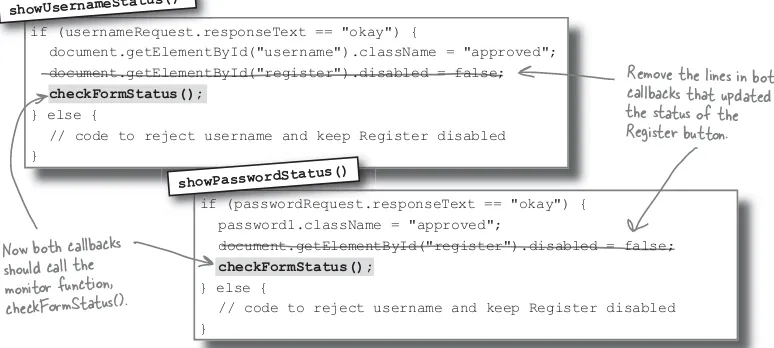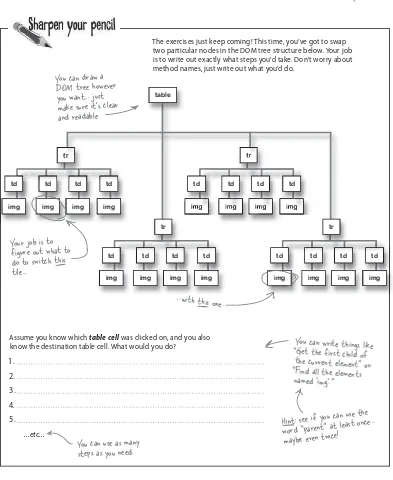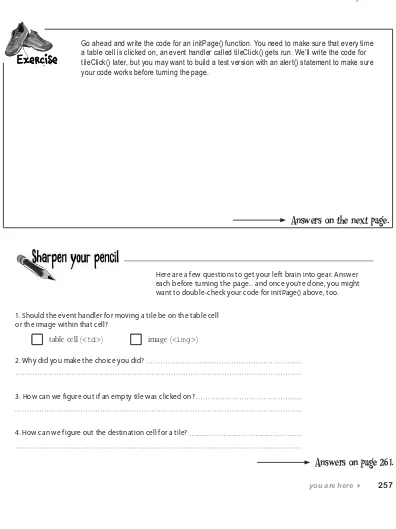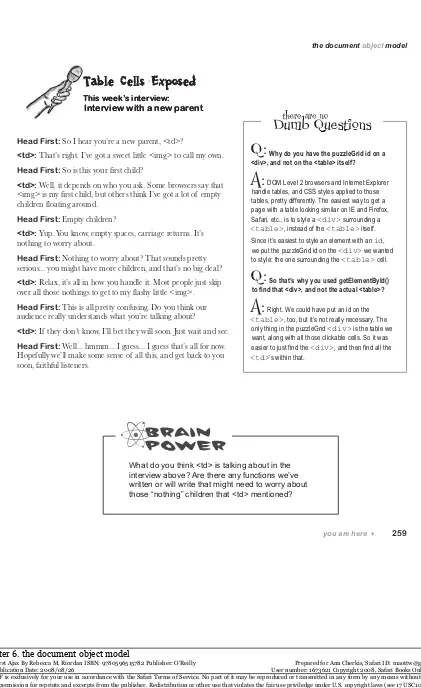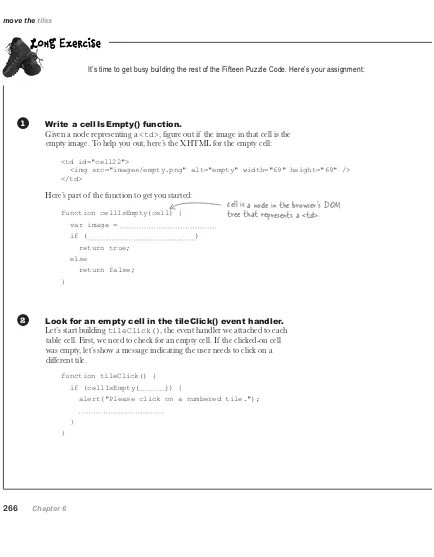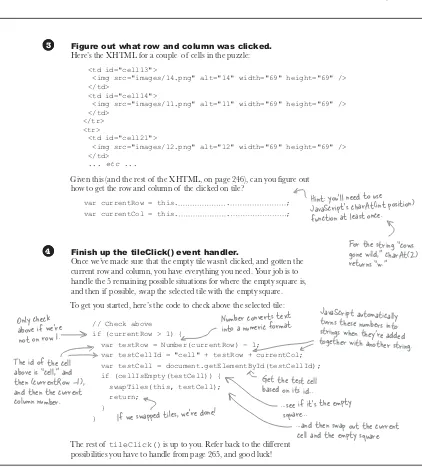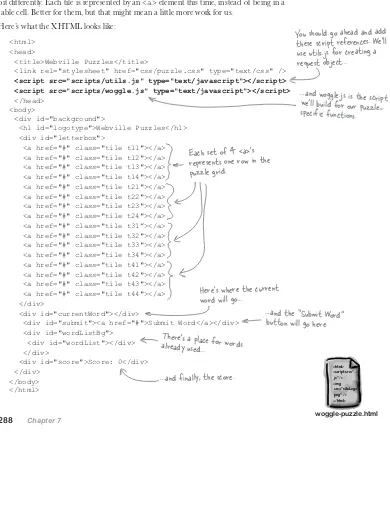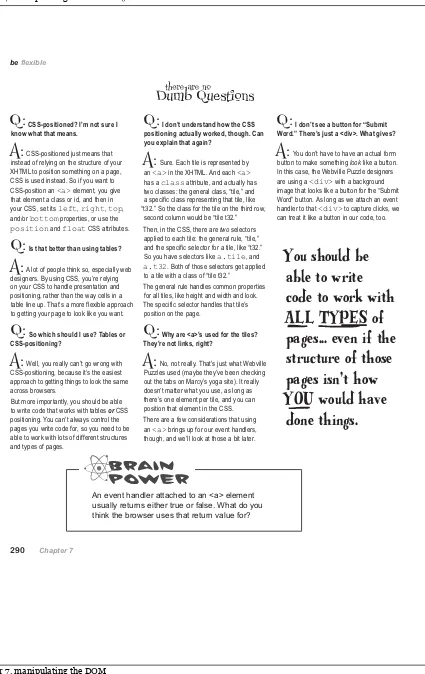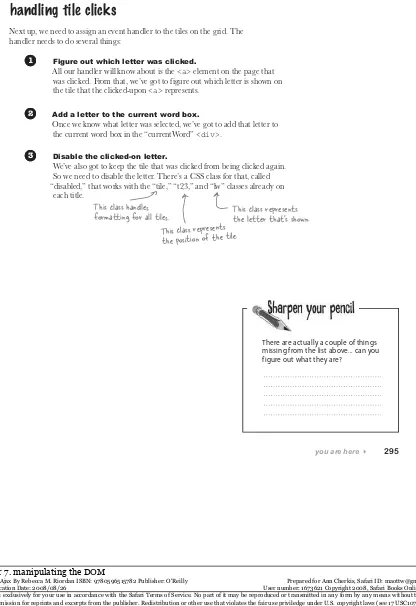Chapter 1. using ajax... 1
Section 1.1. Web pages: the old-fashioned approach... 2
Section 1.2. Web pages reinvented... 3
Section 1.3. So what makes a page "Ajax"?... 5
Section 1.4. Rob's Rock 'n' Roll Memorabilia... 6
Section 1.5. Ajax and rock 'n' roll in 5 steps... 12
Section 1.6. Step 1: Modify the XHTML... 14
Section 1.7. Step 2: Initialize the JavaScript... 16
Section 1.8. Step 3: Create a request object... 20
Section 1.9. Step 4: Get the item's details... 22
Section 1.10. Let's write the code for requesting an item's details... 24
Section 1.11. Always make sure you have a request object before working with it... 25
Section 1.12. The request object is just an object... 26
Section 1.13. Hey, server... will you call me back at displayDetails(), please?... 27
Section 1.14. Use send() to send your request... 28
Section 1.15. The server usually returns data to Ajax requests... 30
Section 1.16. Ajax is server-agnostic... 31
Section 1.17. Use a callback function to work with data the server returns... 35
Section 1.18. Get the server's response from the request object's responseText property... 36
Section 1.19. Goodbye traditional web apps... 38
using ajax
1
Web Apps for a New
Generation
Tired of waiting around for your page to reload?
)UXVWUDWHGE\FOXQN\ZHEDSSOLFDWLRQLQWHUIDFHV",W¶VWLPHWRJLYH\RXUZHEDSSVWKDW VOLFNUHVSRQVLYHGHVNWRSIHHO$QGKRZGR\RXGRWKDW":LWKAjax\RXUWLFNHWWR
EXLOGLQJ,QWHUQHWDSSOLFDWLRQVWKDWDUHmore interactive, more responsive, DQGeasier to use6RVNLS\RXUQDSLW¶VWLPHWRSXWVRPHSROLVKRQ\RXUZHEDSSV,W¶VWLPHWR
JHWULGRIXQQHFHVVDU\DQGVORZIXOOSDJHUHIUHVKHVIRUHYHU
2
Chapter 1Web pages: the old-fashioned approach
With traditional web pages and applications, every time a user clicks on
something, the browser sends a request to the server, and the server responds
with a
whole new page
. Even if your user’s web browser is smart about
caching things like images and cascading style sheets, that’s a lot of traffic
going back and forth between their browser and your server... and a lot of
time that the user sits around waiting for full page refreshes.
The user clicks
something on
your page.
The browser
sends a request
to the server.
The server sends back
a whole new page,
with all the changed
information.
The user clicks
something else.
The browser sends
another request to
the server.
And the server
sends back another
whole page...
Most of the time, only a single line or image is
Web pages reinvented
This time, your page’s code creates
a special request object that the
browser sends to the server.
The server updates
the request object...
...and your code tells the
browser to update only the
parts of the page that
have changed.
Using Ajax, your pages and applications only ask the server for what they
really need—just the parts of a page that need to change, and just the parts
that the server has to provide. That means less traffic, smaller updates, and
less time sitting around
waiting for page refreshes.
With Ajax, the browser only sends and receives
the parts of a page that need to change.
The user clicks
something.
Sometimes the browser doesn’t have to
talk to the server at all.
The browser calls
a function in
your script file.
The script tells the browser
how to update the page... all
The script can update the
image without the server-side
program at all!
request
request
With Ajax, the user doesn’t
have to suffer page f
lickers
or lots of waiting around...
they can even keep using the
page while the reques
t is
being processed.
function getDetails { ... }
4 Chapter
12ND\,JHWWKDW$MD[PDNHVZHESDJHV UHVSRQGIDVWHUEXWZKDWH[DFWO\LVLW"
Ajax is a new way of using
existing technologies.
Ajax isn’t a whole new technology that you
have to learn, like CSS or JavaScript, or a set
of graphics techniques you’ll need to crack
open PhotoShop to accomplish. Ajax is just a
new way of thinking about how to do
what
you’re already doing,
using technologies
you probably already know.
<html>
...
</html>
function
getDetails {
...
}
#mystyle{
...
}
XHTML files scripts style sheets other
resources
The browser sends
requests and gets
responses from a
web server.
Your page can
use images, Flash
animations, Silverlight,
or anything else you
want or need.
So what makes a page “Ajax” ?
Ajax is a way of designing and building web pages that are as interactive and
responsive as desktop applications. So what does that mean for you? You
handle things at the client’s browser whenever you can. Your pages make
asynchronous requests that allow the user to keep working instead
of waiting for a response. You only update the things on your pages that
actually change. And best of all, an Ajax page is built using standard Internet
technologies, things you probably already know how to use, like:
Q:
Doesn’t Ajax stand for “Asynchronous JavaScript and XML”?A:
Sort of. Since lots of pages that are considered “Ajax” don’t use JavaScript or XML, it’s more useful to define Ajax as a way of building web pages that are as responsive and interactive as desktop applications, and not worry too much about the exact technologies involved.Q:
What exactly does “asynchronous” mean?A: In Ajax, you can make requests to the server without
making your user wait around for a response. That’s called an asynchronous request, and it’s the core of what Ajax is all about.
Q:
But aren’t all web pages asynchronous? Like when a browser loads an image while I’m already looking at the page?A:
Browsers are asynchronous, but the standard web page isn’t. Usually when a web page needs information from a server-side program, everything comes to a complete stop until the server responds... unless the page makes an asynchronous request. And that’ what Ajax is all about.Q:
But all Ajax pages use that XMLHttpRequest object, right?A:
Nope. Lots do, and we’ll spend a couple of chapters mastering XMLHttpRequest, but it’s not a requirement. In fact, lots of apps that are considered Ajax are more about user interactivity and design than any particular coding technique.Ajax applications also use a few things that have been around for a while but
may be new to you, like:
We’ll look at all of
these in detail before
we’re through.
Your users can
keep working
while the
6
Chapter 1Rob’s Rock ‘n’ Roll Memorabilia
Meet Rob. He’s put all his savings into an online rock n’ roll
memorabilia store. The site looks great, but he’s still been getting
tons of complaints. Customers are clicking on the thumbnail images
on the inventory page, but the customers’ browsers are taking forever
before they show information about the selected item. Some of
Rob’s users are hanging around, but most have just stopped coming
to Rob’s online shop altogether.
This pane
contains
thumbnails of
the items Rob
has for sale.
When the user clicks
an item, a bigger
picture of the image
is displayed here...
...and the details
about the item
are shown here.
,·PGHVSHUDWHEXW,FDQ·W DIIRUGDPRUHSRZHUIXOVHUYHURU
DWHDPRIZHEH[SHUWV
Ajax pages only talk to the
server when they have to...
and only about what the
server knows.
The user clicks
a thumbnail.
The browser sends
the selected item’s ID
to the server.
The server sends
back a new page,
with the selected
item’s information.
The browser sends
the new item’s ID
to the server.
The server sends
back another whole
new page.
The user gets
tired of waiting
and does
something else...
The user clicks
another thumbnail.
Here’s what Rob’s online store does right now. What’s wrong with this picture?
8
Chapter 1The user clicks
a thumbnail.
Clicking an image calls a
JavaScript function.
The function also
changes the image
to match the
selected item.
The function creates
a request object that
asks the server for a
description of the item.
The browser
The browser requests the new image
from the server... but that’s not
something your page worries about.
Only the part
of the page that
actually changed
is updated... but
the user still sees
a new image and
the selected item’s
description.
Asynchronous requests allow more than one thing to happen at the same time.
Only the part of a web page that needs to change gets updated.
The page isn’t frozen while the server is returning data to the browser.
request
request Your job was to think about how Ajax could help save Rob’s site... and his business. With Ajax, we can completely remove all the page refreshes on his inventory page. Here’s what that would look like:
The server returns
the new image and
a response to the
request to the
user’s browser.
functionPut a checkmark next to the benefits that you think Ajax can provide to your web applications.
The browser can request multiple things from the server at the same time.
Browser requests return a lot faster.
Colors are rendered more faithfully.
Only the parts of the page that actually change are updated.
Server traffic is reduced.
Pages are less vulnerable to compatibility issues.
The user can keep working while the page updates.
Some changes can be handled without a server round-trip.
Your boss will love you.
Only the parts of the page that actually change are updated.
10
Chapter 1Remember, not every page is going to see all these benefits...
The browser can request multiple things from the server at the same time.
Browser requests return a lot faster.
Colors are rendered more faithfully.
Only the parts of the page that actually change are updated.
Server traffic is reduced.
Pages are less vulnerable to compatibility issues.
The user can keep working while the page updates.
Some changes can be handled without a server round-trip.
Your boss will love you.
Only the parts of the page that actually change are updated.
This is only true sometimes. The speed of a request and response depends on what the server is
returning. And it’s possible to build Ajax pages that are slower than traditional pages.
Color rendering is dictated by
the user’s monitor, not your app.
Because Ajax pages rely on technologies in addition to XHTML,
compatibility issues can actually be a bigger problem with Ajax.
Test, test, test your apps on the browsers your users have installed.
If you use Ajax in a way that helps your apps, the boss
will love you. But you shouldn’t use Ajax everywhere...
more on that later.
It’s possible to make smaller, more focused requests with Ajax. Be careful,
though... it’s also easy to make a lot more requests-and increase
traffic-because you can make all of those requests asynchronously.
Sometimes you want a user to wait on the server’s response, but that doesn’t mean you
can’t still use Ajax. We’ll look at synchronous vs. asynchronous requests more in Chapter 5.
Handling things at the browser can make your web
application feel more like a desktop application.
Yes, this is the second time this shows up in the list. It’s that important!
With asynchronous requests, you can make sure the browser works behind the
scenes, and avoid interrupting your users with full-page refreshes.
?
EXWHowardVDLGWKHUH·VEH
PXFKOHVVWUDIILFWKLVZD\ :HOO\HVGHDUXQOHVVeveryoneGHFLGHGWKH\·GWU\WKH VDPHDSSURDFK1RZORRNDWWKH
PHVVZH·UHLQ:KDWDMDP
Q:
First you said Ajax was the web reinvented. Now it’s increasing server traffic. Which is it?A:
Sometimes it’s both! Ajax is one way to make requests, get responses, and build responsive web apps. But you’ve still got to be smart when deciding whether an asynchronous request or a regular synchronous request would be a better idea.Q:
How do I know when to use Ajax and asynchronous requests, and when not to?A:
Think about it like this: if you want something to go on while your user’s still working, you probably want an asynchronous request. But if your user needs information or a response from your app before they continue, then you want to make them wait. That usually means a synchronous request.Q:
So for Rob’s online store, since we want users to keep browsing while we’re loading product images and descriptions, we’d want an asynchronous request. Right?A:
Exactly. That particular part of Rob’s app—checking out different items—shouldn’t require the user to wait every time they select a new item. So that’s a great place to use Ajax and make an asynchronous request.Q:
And how do I do that?12
Chapter 1Ajax and rock ‘n’ roll in 5 steps
Let’s use Ajax to fix up Rob’s online store, and get his impatient customers back.
We’ll need to make some changes to the existing XHTML page, code some
JavaScript, and then reference the script in our XHTML. When we’re done, the
page won’t need to reload at all, and only the things that need to change will get
updated when users click on the thumbnail images.
Here’s what we’re going to do:
Modify the XHTML web page
We need to include the JavaScript file we’re going to write and
add some
div
s and
id
s, so our JavaScript can find and work
with different parts of the web page.
1
1
Write a function to initialize the page
When the inventory page first loads, we’ll need to run some JavaScript
to set up the images, get a request object ready, and make sure the
page is ready to use.
2
2
thumbnails.js will contain
the JavaScript code we
write for handling clicks on
the thumbnail images and
talking to Rob’s server to
get detailed information
about each item.
This tells the
browser to run the
initPage() function
as soon as the page
loads up.
We’ll write code in initPage() to initialize
all the thumbnail images, and set up
onClick event handlers for each image.
thumbnails.js
reference thumbnails.js in
our XHTML page.
We’ll group the
thumbnails into
a <div>, so our
JavaScript can
locate them on the
page easily.
Write a function to create a request object
We need a way to talk to the server and get details about each piece of
memorabilia in Rob’s inventory. We’ll write a function to create a request object to
let our code talk to the server; let’s call it createRequest(). We can use that
function whenever a thumbnail is clicked to get a new request started.
3
3
Get an item’s details from the server
We’ll send a request to Rob’s server in getDetails(),
telling the browser what to do when the server responds.
4
4
Display the item’s details
We can change the image to display in getDetails(). Then, we
need another function, displayDetails(), to update the item’s
description when the server responds to our requests.
5
5
getDetails() will call the createRequest()
function to get a request object.
createRequest() returns
a request object for our
onclick function to use.
createRequest() is a
utility function we’ll
use over and over. It
creates a basic, generic
request object.
request
All we need to do t
o
update the image is
change that image’s src
property. The browser
will handle ev
The request object has
information about what
code should run when the
server responds.
The event handler changes
out the image...
...and another function
we’ll write can take the
server’s information and
display it on the web page.
14
Chapter 1<html>
...
</html>
inventory.html
<!DOCTYPE html PUBLIC "-//W3C//DTD XHTML 1.0 Transitional//EN" "http://www.w3.org/TR/xhtml1/DTD/xhtml1-transitional.dtd"> <html xmlns="http://www.w3.org/1999/xhtml">
<head>
<title>Rob's Rock 'n' Roll Memorabilia</title> <link rel="stylesheet" href="css/default.css" />
VFULSWVUF VFULSWVWKXPEQDLOVMVW\SH WH[WMDYDVFULSW!VFULSW!
</head> <body>
<div id="wrapper">
<img src="images/logotypeLeft.png" alt="Rob's Rock 'n' Roll Memorabilia" width="394" height="91" id="logotypeLeft" />
<img src="images/logotypeRight.png" alt="Rob's Rock 'n' Roll Memorabilia" width="415" height="92" id="logotypeRight" />
<div id="introPane">
<p>Are you looking for the perfect gift for the rock fan in your life? Maybe you want a guitar with some history behind it, or a conversation piece for your next big shindig. Look no further! Here you'll find all sorts of great memorabilia from the golden age of rock and roll.</p> <p><strong>Click on an image to the left for more details.</strong></p> </div>
<div id="thumbnailPane">
<img src="images/itemGuitar.jpg" width="301" height="105" alt="guitar" title="itemGuitar" id="itemGuitar" />
<img src="images/itemShades.jpg" alt="sunglasses" width="301" height="88" title="itemShades" id="itemShades" />
<img src="images/itemCowbell.jpg" alt="cowbell" width="301" height="126" title="itemCowbell" id="itemCowbell" />
<img src="images/itemHat.jpg" alt="hat" width="300" height="152" title="itemHat" id="itemHat" />
</div>
<div id="detailsPane">
<img src="images/blank-detail.jpg" width="346" height="153" id="itemDetail" />
<div id="description"></div> </div>
</div> </body> </html>
Step 1: Modify the XHTML
Let’s start with the easy part, the XHTML and CSS that
create the page. Here’s Rob’s current version of the inventory
page with a few additions we’ll need:
You need to add a
reference to thumbnails.js.
That’s the script we’ll be
writing in this chapter.
It’s time to get the samples and get going.
Download the examples for the book at
www.headfirstlabs.com
, and find the
chapter01
folder. Now open the
inventory.html
file in a text
editor, and make the changes shown above.
This <div> holds the sma
ll,
clickable images.
This <div> is where details
about each item should go.
body {
background: #333;
font-family: Trebuchet MS, Verdana, Helvetica, Arial, san-serif; margin: 0;
text-align: center; }
p { font-size: 12px; line-height: 20px; } a img { border: 0; }
#wrapper {
background: #750505 url('../images/bgWrapper.png') 8px 0 no-repeat; border: solid #300;
border-width: 0 15px 15px 15px; height: 700px;
margin: 0 auto; ...etc...
This is the cascading
style sheet for Rob’s
page. We’ll use the id
values on the <div>
elements to style the
page, and also later in
our JavaScript code.
To Do
Modify the XHTML Initialize the page Create a request object Get the item’s details Display the detailsHere’s a short
version of the steps
from pages 12 and
13 that we can use
to work through
Rob’s page.
blank area for the
item’s description
to go in when
something’s selected.
16 Chapter
1To Do
Modify the XHTML Initialize the page Create a request object Get the item’s details Display the detailsStep 2: Initialize the JavaScript
We need to create the
thumbnails.js
file, and add a JavaScript
function to set up the initial event handlers for each thumbnail image in
the inventory. Let’s call that function
initPage(),
and set it to run
as soon as the user’s window loads the inventory page.
The initPage() function should
get called as soon as the browser
creates all the objects on the page.
initPage() sets up the onclick
behavior for each of the
thumbnails in the inventory.
To set up the onclick behavior for the thumbnails,
the initPage() function has to do two things:
Find the thumbnails on the page
The thumbnails are contained in a
div
called “thumbnailPane,” so we can find that
div,
and then find each image within it.
1
1
Build the onclick event handler for each thumbnail
Each item’s full-size image is named with the title of the thumbnail image
plus “-detail”. For example, the detail image for the thumbnail with the title
FenderGuitar
is
FenderGuitar-detail.png
. That lets us work out the
name of the image in our JavaScript.
The event handler for each thumbnail should set the
src
tag for the detail image (the
one with an id of “itemDetail”) to the detail image (for example,
FenderGuitar-detail.png
). Once you’ve done that, the browser will automatically display the
new image using the name you supplied.
2
2
Code Magnets
The code for the initPage function is all scrambled up on the fridge. Can you put back the pieces that fell off? Remember to set an event handler to run the initPage() function when the user’s window loads, too.
}
window.onload = initPage; function initPage() {
thumbs = document.getElementById("thumbnailPane").getElementsByTagName("IMG"); for (var i=0; i<thumbs.length; i++) {
image = thumbs[i];
detailURL = 'images/' + this.title + '-detail.jpg'; // find the full-size image name
// set the handler for each image // find the thumbnails on the page
// create the onclick function image.onclick = function() {
document.getElementById("itemDetail").src = detailURL; getDetails(this.title);
} }
18
Chapter 1for (var i=0; i<thumbs.length; i++) {
image = thumbs[i];
detailURL = 'images/' + this.title + '-detail.jpg'; // find the full-size image name
// set the handler for each image // find the thumbnails on the page
// create the onclick function
image.onclick = function() {
All these “get...” functions use
the DOM to look up something
on the XHTML page.
We want to do this once
for every thumbnail.
JavaScript lets you define functions
without giving them an explicit name.
Don’t forget all the
closing brackets, or your
JavaScript won’t run.
}}
This sets initPage() up t
o
run once the user’s browser
loads the page.
These are the same ids we used
in the CSS to style the page.
Clicking on a thumbnail changes the
detail image’s src a
ttribute, and then
the browser displays the new image.
This function is
run whenever a
thumbnail image
is clicked.
Don’t worry too much about
this now... we’ll talk about the
DOM in detail a bi
t later.
Test Drive
Create thumbnails.js, add the initPage() function, and
give the inventory page a whirl.
Create a file named
thumbnails.js
in a text editor. Add the code
shown on page 18, and then load
inventory.html
in your browser.
initPage()
should run when the page loads, and you’re ready to try
out the detail images...
Click here....
...and an image is displayed here.
To Do
Update the XHTML Initialize the JavaScript Create a request object Get the item’s details Display the detailsYou can check another
item off the To Do lis
t
for Rob’s inventory page.
20
Chapter 1function createRequest() { try {
request = new XMLHttpRequest();
} catch (tryMS) {
try {
request = new ActiveXObject("Msxml2.XMLHTTP");
} catch (otherMS) {
try {
request = new ActiveXObject("Microsoft.XMLHTTP"); } catch (failed) {
Step 3: Create a request object
When users click on an item’s image, we also need to send a request
to the server asking for that item’s detailed information. But before we
can send a request, we need to create the request object.
The bad news is that this is a bit tricky because different browsers
create request objects in different ways. The good news is that we can
create a function that handles all the browser-specific bits.
Go ahead and create a new function in
thumbnails.js
called
createRequest(),
and add this code:
This line tries to create a new
request object, but it won’t work
for every browser type.
That didn’t work either,
so try one more thing.
If the code gets here, nothing
worked. Return a null so that
the calling code will know there
was a problem.
This either returns a
request object, or “null”
if nothing worked.
Create a request object Get the item’s details Display the detailsReady Bake code is code
that you can just typ
e
in and use... but don’t
worry, you’ll understand
all of this in just another
chapter or two.
The first approach failed, so try again
using a different type of objec
t.
Q:
Am I supposed to understand all of this?A:
No, you’re not. For now, just try to get a general idea of how all this looks and the way the pieces fit together. Focus on the big picture, and then we’ll start to fill in the gaps in later chapters.Q:
So what’s an XMLHttpRequest?A:
XMLHttpRequest
is what most browsers call the request object that you can send to the server and get responses from without reloading an entire page.Q:
Well, if that’s an XMLHttpRequest, what’s an ActiveXObject?A:
AnActiveXObject
is a Microsoft-specific programming object. There are two different versions, and different browsers support each. That’s why there are two different code blocks, each trying to create a different version ofActiveXObject
.Q:
And the request object is called XMLHTTP in a Microsoft browser?A:
That’s the type of the object, but you can call your variable anything you’d like; we’ve been usingrequest
. Once you have thecreateRequest()
function working, you never have to worry about these different types again. Just callcreateRequest(),
and then assign the returned value to a variable.Q:
So my users don’t need to be using a specific browser?A:
Right. As long as their browsers have JavaScript enabled,your users can be running any browser they want.
Q:
What if they don’t have JavaScript enabled?A:
Unfortunately, Ajax applications require JavaScript to run.22 Chapter
1To Do
Modify the XHTML Initialize the page Create a request objectGet the item’s details
Display the details
Ready Bake
Code
Step 4: Get the item’s details
Once a user clicks on an item in the inventory, we need to send a request
to the server and ask for the description and details for that item. We’ve
got a request object, so here is where we can use that.
And it turns out that no matter what data you need from the server, the
basic process for making an Ajax request always follows the same pattern:
Get a request object
We’ve already done the work here. We just need to call
createRequest()
to get an instance of the request
object and assign it to a variable.
request
imageID=escape(imageName)
1
The createRequest() function r
eturns
a request object that our code in
getDetails() can use t
o talk to the server.
Configure the request object’s properties
The request object has several properties you’ll need to set.
You can tell it what URL to connect to, whether to use GET
or POST, and a lot more... you need to set this all up before
you make your request to the server.
2
url="getDetails.php?imageId=" + imageID;
open("GET", url, true);
You can tell your request
object where to make its
request, include details
the server will need to
respond, and even indicate
that the request should
be GET or POST.
request
mageID=escape(imageName)
+ imageID;
onreadystatechange=displayDetails;
request
:K\GR\RXWKLQNWKHFDOOEDFNIXQFWLRQLVDVVLJQHGWRD
SURSHUW\FDOOHGRQUHDG\VWDWHFKDQJH":KDWGR\RXWKLQN
WKDWSURSHUW\QDPHPHDQV"
Tell the request object what to do when the
server responds
So what happens when the server responds? The browser looks at
another property of the request object, called
onreadystatechange
.
This lets us assign a
callback function
that should run when the
server responds to our request.
3
onreadystatechange is just another
property of the request objec
t we
can set in our code.
The property’s value
should be the name of a
function to run once the
server’s given an answer
to our request.
This function is
called a callback
function... it
gets “called
back” with the
server’s response.
Make the request
Now we’re ready to send the request off to the server and get a response.
4
The user clicks an image...
...that calls a function
in thumbnails.js...
...which creates
and configures a
request object...
...and makes a request
to the server.
24
Chapter 1function getDetails(itemName) {
request = createRequest();
if (request==null) {
alert("Unable to create request");
return;
}
var url= "getDetails.php?ImageID=" +
escape(itemName);
request.open("GET",url,true);
request.onreadystatechange = displayDetails;
request.send(null);
}
Let’s write the code for
requesting an item’s details
Once we know what our function needs to do, it’s pretty
easy to write the code. Here’s how the steps map to
actual JavaScript in
thumbnails.js
:
Add the getDetails() function to
your version of thumbnails.js
requestGet a request object
1
Configure the request
2
Set the callback function
3
Send the request
4
The onclick handler for each inventory image
calls this function and passes in the clicked
img element’s title attribute, which is the
name of the item the image represents.
We’ve got to check to make
sure the request object
isn’t null... that’s how
we know if there was a
problem creating the object.
escape() takes care of
any characters that
might be a problem in
a request URL string.
thumbnails.js
Always make sure you have a request
object before working with it
The first thing getDetails() does is call createRequest()
to get a request object. But you’ve still got to make sure that object
was actually created, even though the details of that creation are
abstracted away in the createRequest() function:
If the browser doesn’t support
XMLHttpRequest objects,
createRequest() returns a null.
function getDetails(itemName) {
request = createRequest();
if (request==null) {
alert("Unable to create request");
return;
}
var url= "getDetails.php?ImageID=" +
escape(itemName);
request.open("GET",url,true);
request.onreadystatechange = displayDetails;
request.send(null);
}
This line asks for an
instance of the request
object and assigns it to
the variable “request.”
createRequest() returns a
null if it can’t get a request
object. So if we wind up in
this bit of code, we know
something’s gone wrong. We’ll
display an error to the user
and exit the function.
request
or
null
getDetails()createRequest() returns
a request object if it can
obtain one.
And here’s how that looks in
our code...
Ready Bake
Code
26
Chapter 1function getDetails(itemName) {
request = createRequest();
if (request==null) {
alert("Unable to create request");
return;
}
var url= "getDetails.php?ImageID=" +
escape(itemName);
request.open("GET",url,true);
request.onreadystatechange = displayDetails;
request.send(null);
}
We’re still working
on getting the
details for an item.
To Do
Modify the XHTML Initialize the page Create a request objectGet the item’s details
Display the details
The request object is just an object
A request object is just a “normal” JavaScript object, and that means you can
set properties on it and call methods. We can talk to the server by putting
information in the request object.
Let’s break open() down a bit...
request.open(
"GET"
url
true);
The open() method initializes
the connection.
“GET” indicates how to
send the data (the other
option is “POST”).
This is the url for the
server-side script that will respond to
the request.
This means that the request should
be asynchronous. That is, the code
in the browser should continue to
execute while it’s waiting for the
server to respond.
These parameters tell the
request object how we want it
to connect to the server.
This line tells the request object
the URL to call. We send along the
name of the item, so the server
knows which details to send.
Q: Are there other properties of the request object?
A:
Sure. You’ve already seenonreadystatechange
, and when you need to send XML or more complicated data to the server, then there are several others you’ll use. For now, though, we just need theopen()
method andonreadystatechange
.thumbnails.js
function getDetails { ... }
Hey, server... will you call me back at
displayDetails(), please?
The properties of the request object tell the server what to do when it receives the
request. One of the most important is the onreadystatechange property, which
we’re setting to the name of a function. This function, referred to as a
callback
, tells
the browser what code to call when the server sends back information.
The getDetails()
function sends the
request object to
the server.
This is the line
that tells the
browser what code
to call when the
server responds to
the request.
But when the server
responds, the browser
calls displayDetails(),
The server runs
whatever program was
indicated by the request
object’s URL.
getDetails.php
The server responds with
data for the request.
function getDetails(itemName) {
request = createRequest();
if (request==null) {
alert("Unable to create request");
return;
}
var url= "getDetails.php?ImageID=" +
escape(itemName);
request.open("GET",url,true);
request.onreadystatechange = displayDetails;
request.send(null);
}
28 Chapter
1Use send() to send your request
All that’s left to do is actually send the request, and that’s easy... just use the
send()
method on the request object.
...and this means you’re not sending
any extra data with the request.
$UHQ·W\RXIRUJHWWLQJVRPHWKLQJ" :HGRQ·WZDQWWRVHQGQXOOZH ZDQWWRVHQGWKHLWHPQDPH
You can send data in your URL string.
The request object allows us to send all kinds of data in
a variety of ways. In
getDetails()
, the item name is
part of the URL string:
var url= "getDetails.php?ImageID=" +
escape(itemName);
Since that’s part of the URL sent to the server, we don’t
need to send anything else to the server in the
send()
method. Instead, we just pass
null
... which means
“nothing.”
thumbnails.js
function getDetails { ... }
function getDetails(itemName) {
request = createRequest();
if (request==null) {
alert("Unable to create request");
return;
}
var url= "getDetails.php?ImageID=" +
escape(itemName);
request.open("GET",url,true);
request.onreadystatechange = displayDetails;
request.send(null);
}
You’re sending the
request here...
Asynchronous
apps make
requests using
a JavaScript
object, not a
form submit.
6RZKDWDERXWWKH VHUYHUVLGHFRGH"
The server-side code is...
...on the server.
That sounds obvious, but lots of times, you
don’t have to (or even get to) write the code
your web application is talking to. Instead,
you work with an existing program, where
you know the inputs and outputs, or tell
another group what you need.
Not only that, but you might also have one
server-side program that’s written in PHP,
and another in ASP.NET... and other than
the URL, you don’t have to change your
JavaScript code at all. Take a look:
thumbnails.js
function
getDetails {
...
}
getDetails()
displayDetails()
Web Server
request
request
getDetails.php
This is what you need t
o worry
about... the JavaScr
ipt code and
the request object.
Even if this part of things is your
responsibility, it’s totally separate
from your Ajax front-end code.
30
Chapter 1The server usually returns data to Ajax requests
In a traditional web app, the server always responds to a request from the browser by
sending back a new page. The browser throws away anything that’s already displayed
(including any fields the user has filled in) when that new page arrives.
The browser sends a request
to a url, possibly sending
along some request data.
The server sends back an
entire page.
Traditional server-side interactions
The server may do some
processing, or may just
load and send some text,
but it always returns a
full web page.
The server always
does some processing
and sends back data...
sometimes HTML,
sometimes just raw
information.
In an Ajax app, the server can return a whole page, part of a page, or
just some information that will be formatted and displayed on a web
page. The browser only does what your JavaScript tells it to do.
Ajax server-side interactions
The server responds, and
the browser runs your
callback function.
thumbnails.js
function
getDetails {
...
}
getDetails()
displayDetails()
Web Server
request
request
getDetails.php
Our JavaScript can
use the server’s data
to update just part of
the page.
Ajax is server-agnostic
Ajax doesn’t require any particular server technology. You can use
Active Server Pages (ASP), PHP, or whatever you need and have
access to. In fact, there’s no need to get into the details of the
server-side technology because it doesn’t change how you build your
Ajax apps.
Here’s all that Ajax really sees:
request
parametersresponse
This is what we’ll send
to the server.
This is what the server
needs to send back.
This is how
Ajax sees
server-side
interactions.
What parameter and response do we need for the interaction with the server for Rob’s memorabilia page?
32
Chapter 1:KDWKDSSHQV":KDW¶VZURQJZLWKWKHSDJH"
:KDWGR\RXQHHGWRGRWRIL[WKHSUREOHP"
Test Drive
Code getDetails(), and fire up your web browser.
Make sure you’ve got
getDetails()
coded in your
thumbnails.js
file. Load up Rob’s memorabilia page, and try
clicking on one of the inventory images.
readyState
Below on the left are several properties of the request object. Can you
match each property to what it does, or what information it contains?
responseText
responseXML
status
statusText
Q:
Can you explain what a callback function is again?A:
A callback function is a function that is executed when something else finishes. In Ajax, it’s the function that’s called when the server responds to a request object. The browser “calls back” that function at a certain time.Q:
So a callback executes when the server’s finished with a request?A:
No, it’s actually called by the browserevery time the server responds to the request, even if the server’s not totally done with the request. Most servers respond more than once to say that they’ve received the request, that they’re working on the request, and then, again, when they’ve finished processing the request.
Q:
Is that why the request property is called onreadystatechange?A:
That’s exactly right. Every time the server responds to a request, it sets thereadyState property of the request
object to a different value. So we’ll need to pay close attention to that property to figure out exactly when the server’s done with the request we send it.A number that represents the
current state of the request object.
Contains textual information
sent back by the server.
Contains information sent back
by the server in XML format.
34
Chapter 1The status code message returned
by the server, for example, “OK” for
status 202.
readyState
Below on the left are several properties of the request object. Your job was
to match each property to what it does, or what information it contains.
responseText
responseXML
status
statusText
status and
statusText are
different versions of
the same information.
This one indicates that a request
is finished, and it’s now okay to
process the server’s results.
This is empty unless the server
sends back data in XML format.
This is empty unless the
server sends back data as
text (and not XML).
Jfclk`fe
A number that represents the
current state of the request object.
Contains textual information
sent back by the server.
Contains information sent back
by the server in XML format.
Use a callback function to work with
data the server returns
How do we show the textual description for each item? Let’s assume the
server will send the details about an item as pre-formatted text in the
responseText
property of the request object. So we just need to get
that data and display it.
Our callback function,
displayDetails()
, needs to find the
XHTML element that will contain the detail information, and then set its
innerHTML
property to the value returned by the server.
request
responseText
The server returns the details
in the responseText property
of the request object.
To Do
Modify the XHTML Initialize the page Create a request object Get the item’s detailsDisplay the details
thumbnails.js
function
getDetails {
...
}
displayDetails()
Our callback function can use
the response data...
...and update the web page with
the requested item’s details.
Q:
So the server calls displayDetails() when it’s finished with the request?36 Chapter
1detailDiv = document.getElementById("description");
detailDiv.innerHTML = request.responseText;
}
}
}
Get the server’s response from the
request object’s responseText property
The data we want is in the request object. Now we just need to get that
data and use it. Here’s what we need:
This line gets a reference to
the XHTML element we’ll
put the item details in.
This line puts the XHTML returned
by the server into that element.
Q:
What’s that readyState property?A:
That’s a number that indicates wherethe server is in its processing. 0 is the initial value, and when the server’s completed a request, it’s 4.
Q:
So that first statement just checks to see if the server’s finished with the request?A: You got it.
Q:
Why do we have to check that every time?A:
Because the browser will run your callback every time the ready state changes. Since a server might set this value to 1 whenit receives the request, and to 2 or 3 as it’s processing your request, you can’t be sure the server’s done unless readyState is equal to 4.
Q:
And the status property?A:
That’s the HTTP status code, like 404for forbidden, and 200 for okay. You want to make sure it’s 200 before doing anything with your request object.
Q:
Why would the server set the ready state to 4 when the status code is something like 404?A:
Good question. We’ll talk about that in the next chapter, but can you think of how a request could be complete and still have a status code that indicates a problem?Q:
Isn’t innerHTML a bad thing to use?A:
It is, but sometimes it’s also veryeffective. We’ll look at better ways to change a page when we get more into the DOM in later chapters. For now, though, it works, and that’s the most important thing.
Q:
Am I supposed to be getting all this? There’s sure a lot going on in that callback function...A:
For now, just make sure you know that the callback is where you can use the server’s response. We’ll talk about callbacks, ready states, and status codes a lot more in Chapter 2.It’s okay if all of
this isn’t completely
clear to you. We’ll
look at ready states
and status codes in
a lot more detail in
the next chapter.
Test Drive
Code your callback, and test out the inventory page.
Add
displayDetails() to your thumbnails.js file. You should also make
sure that the server-side program with the inputs and outputs detailed on page 30
is running, and that the URL in your getDetails() method is pointing to that
program. Then fire up the inventory page and click on an item.
When you click on an item, you
should see both a larger image
of the item, and details about
it.. all without a page reload.
Confused about getting your
server-side program working?
38
Chapter 1Goodbye traditional web apps...
Rob’s page is working more smoothly now, customers are coming
back in droves, and you’ve helped pair vintage leather with the
next-generation web.
$PD]LQJZRUN,·YH DOUHDG\JRWVRPHLGHDV
IRURXUQH[WSURMHFW
...only changed the part of
the page that needed to
be updated.
Rob’s new, Ajax app:
...lets users keep viewing
the page while images
and descriptions are
loaded behind the scenes,
asynchronously.
...reduced the need for his
users to have super-fast
connections to use his site.
...reloaded the entire page
when a user clicked on an
LWHP·VWKXPEQDLOLPDJH
Rob’s old, traditional web app:
...took a long time to load
because the entire page
had to be rendered by the
browser on every click.
...felt unresponsive because
the user had to wait on all
those page refreshes.
...lost Rob business, annoyed
his customers, and drained
his bank account.
Compare these benefi
ts
with the list on page
10... they should look
pretty similar.
These aren’t problems tha
t
just Rob’s having. Almos
t all
traditional web apps hav
e
these problems in some f
orm
or fashion.
AjaxAcrostic
Take some time to sit back and give your right brain something to do. Answer
\PMY]M[\QWV[QV\PM\WX\PMV][M\PMTM\\MZ[\WÅTTQV\PM[MKZM\UM[[IOM
This is the language you use to script Ajax pages.
This type of function gets called when a process completes.
This request object property tells us when the server has finished processing.
If something goes wrong at the server, this property will tell us what.
The browser will put text that the server returns in this property.
If there’s a problem, we can get a description of it in this property.
47 48 49 50 51 52 53 54 55 56
35 36 37 38 39 40 41 42 43 44 45 46
29 30 31 32 33 34
19 20 21 22 23 24 25 26 27 28
11 12 13 14 15 16 17 18
1 2 3 4 5 6 7 8 9 10
49 1 31 45 13 54 10 29 23 39 33
15 51 8 14 22 19 28 37 9 39 40 34 8 3 44
31 9 38 14 8 6 26 46 8 39 40 24
40
Chapter 1request
item name
What parameter and response do we need to implement Rob’s page?
We’ll send the server the name
of the item, which is stored
in the title attribute of that
item’s image in the XHTML.
The server will send back the
formatted XHTML tha
t
describes the item.
item details
From page 31
AjaxAcrostic Solution
Take some time to sit back and give your right brain something to do. Answer
\PMY]M[\QWV[QV\PM\WX\PMV][M\PMTM\\MZ[\WÅTTQV\PM[MKZM\UM[[IOM
This is the language you use to script Ajax pages.
This type of function get called when a process completes.
This request object property tells us when the server has finished processing.
If something goes wrong at the server, this property will tell us what.
The browser will put text that the server returns in this property.
If there’s a problem, we can get a description of it in this property.
Chapter 2. designing ajax applications... 1
designing ajax applications
2
Thinking Ajaxian
Welcome to Ajax apps—it’s a whole new web world.
6R\RX¶YHEXLOW\RXUILUVW$MD[DSSDQG\RX¶UHDOUHDG\WKLQNLQJDERXWKRZWR FKDQJHDOO\RXUZHEDSSVWRPDNHUHTXHVWVDV\QFKURQRXVO\%XWWKDW¶VQRWDOO WKHUHLVWR$MD[SURJUDPPLQJ<RX¶YHJRWWRthink about your applications differently-XVWEHFDXVH\RX¶UHPDNLQJDV\QFKURQRXVUHTXHVWVGRHVQ¶WPHDQ \RXUDSSOLFDWLRQLVXVHUIULHQGO\,W¶VXSWR\RXWRKHOS\RXUXVHUVavoid making mistakesDQGWKDWPHDQVrethinking\RXUHQWLUHDSSOLFDWLRQ¶Vdesign.'RLQJWZRWKLQJVDW RQFHZLWK$MD[JRVKLW·V WKHEHVW%XW,PXVWDGPLW, KDYHWRWKLQNDERXWWKLQJVLQD
44
Chapter 2Mike’s traditional web site sucks
Mike’s got the hippest movie reviews going, and he’s taking his popular
opinions online. Unfortunately, he’s having problems with his registration
page. Users visit his site, select a username, type in a few other details, and
submit their information to get access to the review site.
The problem is that if the username’s taken, the server responds with the
initial page again, an error message... and none of the information the user
already entered. Worse, users are annoyed that after waiting for a new page,
they get nothing back but an error message. They want movie reviews!
Right now the user
fills out the form and
clicks the “Register”
button... and then
waits, and hopes for
the best.
Note from HR: Can we use a less offensive
term? How about “consistently annoys every
one of Mike’s users”?
,·PJHWWLQJWRQV RIUHJLVWUDWLRQVVRORWVRI XVHUQDPHVDUHDOUHDG\WDNHQ7KLVLV KRZHYHU\RQHHOVHKDQGOHVVLJQXSVEXW ,·PJHWWLQJIORRGHGZLWKFRPSODLQWV
&DQ\RXKHOSPHRXW"
Mike’s movie review si
te
looks great and has t
ons
of terrific reviews... but
only if users can get
signed up and past the
registration page.
Mike’s got real problems, but with one Ajax app under your belt, you should probably have some
ideas about what Mike needs. Take a look at the diagram of what happens with Mike’s app now,
and make notes about what you think
should
happen. Then, answer the questions at the bottom
of the page about what you’d do to help Mike out.
The server displays a
Welcome screen...
...or it re-displays
the screen with an
error message.
Everything the user
entered is gone… the
fields are all empty.
Web Server
A new user fills out the registration form
1
The form is submitted to a web server
2
or
3
A server-side program verifies and
validates the registration information...
4
...and returns a new web page to the
XVHU·VZHEEURZVHU
What do
you
think is the single biggest problem with Mike’s site?
46 Chapter
2Let’s use Ajax to send registration
requests ASYNCHRONOUSLY
Ajax is exactly the tool you need to solve the problem with Mike’s page. Right
now the biggest problem is that users have to wait for a full page refresh
to find out their requested username is already taken. Even worse, if they
need to select a different username, they’ve got to re-type all their other
information again. We can fix both of those problems using Ajax.
We’ll still need to talk to the server to find out whether a username has been
taken, but why wait until users finish filling out the entire form? As soon
as they enter a username, we can send an
asynchronous request
to the
server, check the username, and report any problems directly on the page—
all
without
any page reloads, and
without
losing the user’s other details.
Let’s check the requested
username as soon as the user
leaves the field.
The user can fill out the rest
of the form while the server
is checking the username.
You already know how
to send an asynchronous
request to the server.
The callback displ
ays
an error only if
there’s a problem.
Meanwhile, the user’s
still working.
The server lets our
callback function
know if the
username is taken
or okay to use.
request
request
Did you write down
something similar to this as
Mike’s biggest problem?
It’s okay if you didn’t
think about sending the
request as soon as the user
types in their username...
but bonus credit if you did!
$OOWKLVMXVWVRVRPHPRYLHEXIIGRHVQ·WKDYH WRUHW\SHWKHLUQDPHDQGHPDLODGGUHVV" 'RHVQ·WWKLVVHHPOLNHDELWRIRYHUNLOO"
Don’t annoy your users... ever!
On the Internet, your competitors are only a
click away. If you don’t tell your users about a
problem right away, or if you ever make them
re-do something, you’re probably going to lose
them forever.
Mike’s site may not be a big moneymaker (yet), or
even seem that important to you... but it might to
his fans. One day a user you’re helping him not
annoy may land him a six-figure income writing
movie reviews for the New York Times. But Mike
won’t ever know if his site is hacking his users off.
That’s where your Ajax skills can help.
Don't annoy your users
If there’s a problem with
your web app, let your users
know about it as quickly
and clearly as possible. And
you should never throw away
anything the user has already done, even
if something happened that they (or you)
weren’t expecting.
Important Ajax design principle
Q:
That design principle isn’t really Ajax-specific, is it?48
Chapter 2It’s time to get to work on Mike’s site. Below are 5 steps that you’ll need to execute to get
his site working, but the details about each step are missing, and the ordering is a mess.
Put the steps in order, and write a sentence or two about exactly what should happen on
each step.
Verify the requested username
?
?
Set up event handlers for the w
eb form’s fields
?
?
Create and configure a new request object
?
?
Report any problems with the requested username
?
?
Update the registration page’s XHTML and CSS
?
After you’ve got your steps in order, take a look at the two diagrams below that describe
some of the interactions in an Ajax version of Mike’s app. See if you can fill in the blanks so
that the diagrams are complete and the annotations are accurate.
The JavaScript function crea
tes and
the object.
The request object tells
the what
the user chose.
The returns a value indicating
whether the has been .
The function updates the page to show success
or failure without .
The event triggers a
call to our JavaScript.
request
username
request
